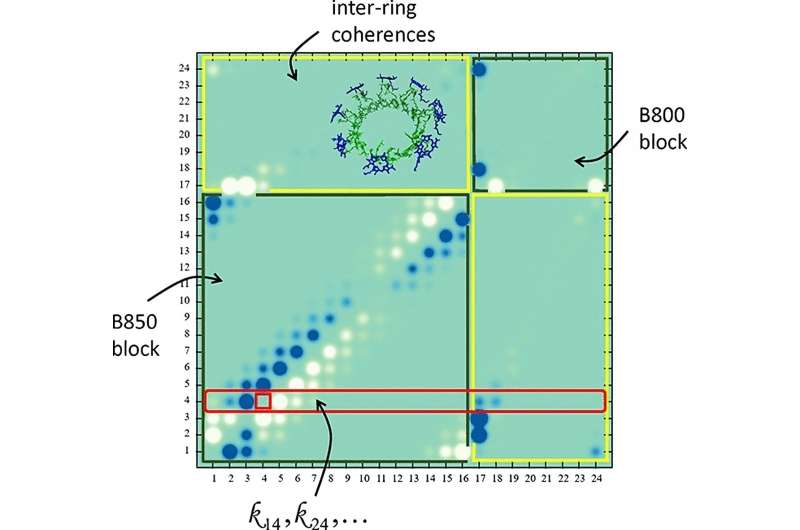This article has been reviewed according to Science X's editorial process and policies. Editors have highlighted the following attributes while ensuring the content's credibility:
fact-checked
peer-reviewed publication
trusted source
proofread
Quantum visualization technique gives insight into photosynthesis

Systems obeying quantum mechanics are notoriously difficult to visualize, but researchers at the University of Illinois Urbana-Champaign have developed an illustration technique that displays quantum features in an easy-to-read diagram called a coherence map. The researchers used these maps to study the quantum mechanisms that underlay photosynthesis, the process by which plants and some bacteria use sunlight to convert carbon dioxide and water into food.
"It was hard to believe how simple coherence maps are," said Nancy Makri, a professor of chemistry at the U. of I. and the project head. "When dealing with nonintuitive quantum phenomena as a part of complex processes like photosynthesis, interpreting theoretical calculations can be quite a challenge. But coherence maps tell you everything you need to know in a snapshot."
In a study published in The Journal of Physical Chemistry Letters, Makri's research group applied coherence maps to analyze earlier computer simulations of photosynthesizing bacteria in a new way. The researchers studied the molecular complex that "harvests" sunlight, absorbing it and transferring its energy to a chemical reaction site where carbon dioxide and water are processed. Coherence maps not only clearly displayed how energy was transferred to the reaction site, but they gave a clear quantum explanation for the transfer.
Makri explained that coherence maps are illustrations of the reduced density matrix, a mathematical object containing all information about a system's quantum behavior. "Even for modestly sized systems, the reduced density matrix becomes quite large, and all its components are interrelated," she said. "It's simply too much information to analyze. With coherence maps, though, there is a ton of information that pops out of the pictures just from a glance."
This information allowed the researchers to identify the energy transfer pathways in the bacterial light harvesting complex "very transparently," according to Makri. The complex contains an outer ring and an inner ring of molecules. The outer ring absorbs sunlight, and the inner ring contains the chemical reaction site. Makri's group showed that the two rings are connected by the motions of the atoms in the molecules, and coherence maps clearly illustrated that these motions focus energy from the outer ring to the inner ring.
"Looking ahead, I believe coherence maps will be an invaluable tool to theoretical analyses based on quantum mechanics," Makri said. "Just in this study, they gave important insights into the photosynthesis mechanism, one of the great mysteries of biology."
Makri's research group reported simulations of the energy transfer mechanism in photosynthesizing bacteria in Science Advances, and the group introduced coherence maps in The Journal of Physical Chemistry B.
More information: Reshmi Dani et al, Coherence Maps and Flow of Excitation Energy in the Bacterial Light Harvesting Complex 2, The Journal of Physical Chemistry Letters (2023). DOI: 10.1021/acs.jpclett.3c00670
Journal information: Journal of Physical Chemistry Letters




















